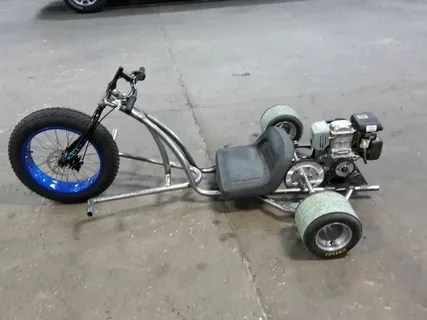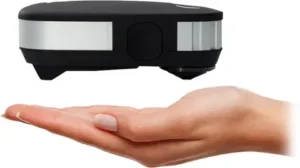Drift trikes are not just a thrilling way to slide around corners; they’re an exhilarating blend of engineering and fun. Picture yourself gliding effortlessly through turns, the rear wheels losing grip as you master the art of drifting. But have you ever wondered what makes some drift trikes handle better than others? The secret often lies in frame geometry.
Understanding how frame design affects performance can elevate your riding experience from ordinary to extraordinary. Whether you’re a weekend warrior or an aspiring pro, knowing the ins and outs of drift trike frame geometry will help you select the perfect setup for your style. Let’s dive into the science behind those slick slides and discover how each element contributes to optimal performance on the asphalt!
The Basics of Frame Geometry
Frame geometry is a fundamental aspect of drift trikes. It influences how the vehicle handles during high-speed slides and turns.
One essential element is the centre of gravity. A lower centre of gravity enhances stability, allowing for smoother drifts. This positioning helps keep the rider grounded while navigating corners.
Another crucial factor is the wheelbase. The distance between the front and rear wheels affects maneuverability. A longer wheelbase provides better straight-line stability, whereas a shorter one increases agility in tight turns.
Caster and camber angles also play significant roles in handling dynamics. Caster angle affects steering responsiveness, while camber helps with tyre contact during cornering.
Understanding these components allows riders to fine-tune their experience on track or street. Each element combines to create a balance that suits different riding styles and preferences.
– Center of Gravity
The centre of gravity is crucial in how a drift trike performs. This invisible point determines balance and stability when you’re sliding through corners.
A lower centre of gravity enhances control. It minimizes the risk of tipping over, allowing smoother transitions during drifts. Riders can confidently lean into turns, knowing their trike won’t quickly flip.
Conversely, a higher centre of gravity can lead to instability. While it may provide agility on flat surfaces, it becomes problematic when navigating tight curves or uneven terrain.
Rider weight also influences this dynamic. You can adjust the trike’s handling characteristics mid-ride by shifting your body position forward or back. This adaptability is critical for mastering tricky maneuvers and achieving that perfect slide.
Understanding your drift trike’s centre of gravity is essential for enhancing performance and enjoying every ride to its fullest potential.
– Wheelbase
Wheelbase is a critical aspect of Drift Tricycle Frame geometry. It refers to the distance between the front and rear axle. This measurement significantly influences how your trike handles during slides.
A shorter wheelbase offers more excellent maneuverability. Riders can make sharper turns, allowing for precise control while drifting. However, this can also lead to instability at high speeds.
Conversely, a longer wheelbase provides better straight-line stability. It helps maintain balance when gliding through wide arcs but may limit sharp turning capabilities.
Finding the correct wheelbase depends on your riding style and experience level. Beginners prefer a slightly longer configuration for added safety, while advanced riders often opt for shorter setups to maximize their drift potential.
Understanding these dynamics is essential for anyone looking to enhance their drift-triking experience.
– Caster and Camber Angles
Caster and camber angles play a crucial role in handling a drift trike. Caster angle refers to the tilt of the steering axis, where a positive caster helps with stability during high-speed maneuvers. This angle influences how your front wheels respond when you turn, providing better control and feedback.
On the other hand, the camber angle pertains to the vertical tilt of the wheels. Negative camber means that the tops of your tyres lean inward towards each other. This adjustment enhances grip during cornering by maximizing tyre contact with the ground.
Getting these angles right can transform your drift experience. Too much or too little can lead to instability, affecting overall performance on different surfaces. Finding that sweet spot for both caster and camber is essential for achieving optimal slide dynamics while effortlessly maneuvering sharp turns.
Importance of Frame Geometry in Drift Trike Performance
Frame geometry is crucial in how a drift trike performs on the track. The design influences stability, control, and overall handling dynamics.
1. Stability
The stability of a drift trike is dependent on its frame geometry. A well-designed frame with proper weight distribution and centre of gravity will provide better stability, allowing the rider to maintain control while drifting at high speeds. The width and length of the frame also play a role in stability, as a broader and longer frame provides more surface area for the trike to balance on.
2. Control
The frame geometry also affects how responsive the trike is to steering inputs. The angle of the head tube, which connects the front wheel to the rest of the frame, determines how quickly and smoothly the trike turns. Additionally, the placement of the handlebars and foot pegs can affect how easily a rider can shift their weight for sharper turns or quick corrections.
3. Weight Distribution
An essential aspect of drift trikes is weight distribution, which affects stability and control. A well-balanced frame design distributes weight evenly across all three wheels, providing better traction and preventing wheel lift during sharp turns or high-speed drifts. This allows for a smoother and more controlled drifting experience.
4. Handling Dynamics
Frame geometry has a direct impact on handling dynamics—how a drift trike behaves while in motion. An adequately designed frame will allow for better maneuverability, precise control, and smooth transitions between turns. The frame’s weight distribution and steering characteristics also affect how easily the trike can initiate and maintain a drift, making it crucial for competitive drifting performance.
A well-thought-out frame geometry allows riders to initiate drifts smoothly, giving them the confidence to push their limits without fear of losing control.
Key Components of Drift Tricycle Frame Geometry
Several key components come into play for optimal handling and performance when exploring drift tricycle frame geometry.
1. Frame Material and Design
The material used to construct the frame plays a crucial role in determining the drift trike’s overall weight, stability, and durability. The most commonly used materials include steel, aluminium, and chrome. The frame design also affects the trike’s handling and maneuverability.
2. Wheelbase
The wheelbase is the distance between the front and rear wheels of the drift trike. A longer wheelbase provides better stability at high speeds but can make it harder to turn and maneuver. On the other hand, a shorter wheelbase allows for quicker turns but may sacrifice some stability.
3. Head Tube Angle
The head tube angle refers to the angle between the head tube (where the fork attaches to the frame) and the ground. A steeper head tube angle results in a quicker steering response, while a more relaxed angle provides more stability.
4. Center of Gravity
The centre of gravity (COG) determines how well a drift trike handles and performs. A lower COG results in better stability and cornering ability while sacrificing some speed due to increased drag from closer to the ground. A higher COG allows faster speeds but may be less stable during turns.
Understanding Wheelbase, Camber, and Caster Angles
Wheelbase plays a crucial role in the stability of a drift trike. A longer wheelbase provides more control, making it easier to maintain balance during slides. Conversely, a shorter wheelbase can enhance maneuverability but may require more skill to handle effectively.
Camber angles affect how the tyres make contact with the ground. Positive camber allows for better cornering grip, while negative camber can improve lateral stability during drifts. Finding the right angle is essential for maximizing performance on different surfaces.
The caster angle influences steering responsiveness and self-centering capabilities of the front wheels. Adjusting this angle affects how quickly you can initiate and recover from a slide.
Understanding these three components helps riders tailor their drift trikes to their specific needs and preferences, enabling them to enjoy smoother rides and sharper turns on any course they tackle.
Finding the Right Frame Drift Trike for Your Riding Style
Choosing the right Frame Drift Trike is crucial. It’s not just about looks; it directly influences how you ride. Consider your riding style first. Are you into tight corners or wide, sweeping slides? A shorter wheelbase might suit those sharp turns, while a longer one provides stability at higher speeds.
Next, consider your body type and weight. Heavier riders often benefit from a sturdier frame that can handle more stress during drifts. Lighter riders may prefer something agile and responsive. Don’t overlook the material, either. Aluminium frames are light but lack some durability compared to steel options.
If possible, test different setups. Feel what works best for you on various terrains before making a final decision. Personal preference plays an enormous role in finding the perfect match for your drift trike adventures!
The Impact of Weight Distribution on Drift Trike Handling
Weight distribution is crucial in how a drift trike handles during rides. It affects stability and responsiveness, impacting the overall performance on different terrains.
When weight is evenly distributed, it allows for smoother cornering. This balance enhances control over slides and drifts. Riders often notice that shifting their body position can significantly influence handling dynamics.
On the other hand, uneven weight distribution can lead to unpredictable behaviour. A heavy front end might cause understeering, while too much weight at the rear could result in oversteering.
Finding the sweet spot is essential for maximizing fun and safety during rides. Experimenting with your stance or adjusting components helps fine-tune this aspect of drifting. Understanding how weight impacts your ride will improve speed and technique on any track or slope you tackle.
How to Modify and Adjust Frame Geometry for Maximum Performance
Modifying and adjusting frame geometry can significantly enhance your drift trike’s performance. Start with the wheelbase. A longer wheelbase provides stability, while a shorter one allows for tighter turns. Experimenting with these dimensions can help you find the sweet spot for your riding style.
Next, consider the caster angle. Increasing this angle can improve steering response but may require practice to master handling at high speeds. Adjusting camber angles is also essential; a slight negative camber enhances grip during cornering.
Weight distribution plays a critical role, too. Shifting weight forward or backward affects how your trike handles in various conditions. Adding or removing components like seat placement or battery location can alter the balance dramatically.
Testing changes on different surfaces helps identify what works best for you. Don’t hesitate to make incremental adjustments until you achieve optimal control and responsiveness on every slide.
Conclusion
Understanding drift trike frame geometry is essential for any enthusiast. It shapes how you ride and the overall experience on the track. Every angle matters, from caster to camber. These elements work together to enhance control and stability during those thrilling slides. Experimenting with different setups can lead to a personalized riding style that suits your preferences. Engage with fellow riders, share insights, and discover new techniques. The journey doesn’t end; it evolves as you develop skill and confidence on your drift trike adventure.
FAQs
What is the ideal wheelbase for a drift trike?
The ideal wheelbase can vary based on your riding style. Generally, a longer wheelbase offers stability and control at high speeds, while a shorter one allows for tighter turns and more agility. It often comes down to personal preference.
How do caster and camber angles affect drifting?
Caster angle affects steering responsiveness. A positive caster angle provides better straight-line stability but can make turning slightly harder. Camber impacts tyre contact with the ground during cornering, influencing grip levels when sliding through turns.
Can I modify my drift trike frame geometry myself?
You can modify your drift trike frame geometry yourself with the right tools and knowledge. Adjustments like changing wheel sizes or tweaking axle positions are common modifications that can enhance performance tailored to your needs.




